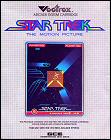 The Game: You’re at the helm of the U.S.S. Enterprise – that’s the cool part. The not-so-cool part? You’re in disputed territory – and the Klingons are bringing the fight to you en masse, attacking both the Enterprise and local Starbases, which you have the defend (lest you be left with no place to refuel). Use your phasers, photon torpedoes and shields judiciously – and do whatever it takes to halt the Klingon advance before they overrun Federation space. (GCE, 1982)
The Game: You’re at the helm of the U.S.S. Enterprise – that’s the cool part. The not-so-cool part? You’re in disputed territory – and the Klingons are bringing the fight to you en masse, attacking both the Enterprise and local Starbases, which you have the defend (lest you be left with no place to refuel). Use your phasers, photon torpedoes and shields judiciously – and do whatever it takes to halt the Klingon advance before they overrun Federation space. (GCE, 1982)
Memories: When the Enterprise returned by way of movie screens around the world in 1979, the sets and other visual details depicting the ship were brought right up to date to withstand big-screen scrutiny (and anticipated repeat viewing – though probably not even the movie’s makers knew to what degree that would be the case). The Enterprise’s onboard computers were shown to display, among other things, vector-graphics-style tactical displays – a fact not lost on the makers of the Vectrex console. Marrying the two was only – dare I say it? – logical.
 At roughly the same time that a fast-moving Star Trek arcade game was arriving courtesy of Sega, a similar – but no less difficult – title arrived on the Vectrex home console. With the speed afforded by vector graphics, both games could be punishingly difficult and fast.
At roughly the same time that a fast-moving Star Trek arcade game was arriving courtesy of Sega, a similar – but no less difficult – title arrived on the Vectrex home console. With the speed afforded by vector graphics, both games could be punishingly difficult and fast.
But why was Vectrex left with a game supposedly based on Star Trek: The Motion Picture – a movie that was now three years in the past, and was already being decried as an over-long, overindulgent mess? The answer lies in a major acquisition made by Gulf+Western, which in 1982 was the parent company of Paramount Studios. At that time, Gulf+Western owned Sega as well as Paramount, so it was a no-brainer of corporate synergy that kept the new arcade game (which had begun its development life somewhat loosely based on Star Trek II‘s Kobayashi Maru test scenes) “in house.” In any case,  the arcade game didn’t bear the Star Trek II title, so the Motion Picture moniker for the Vectrex game was a bit of an out-of-time mystery.
the arcade game didn’t bear the Star Trek II title, so the Motion Picture moniker for the Vectrex game was a bit of an out-of-time mystery.
The Vectrex game itself was a blast, with as much fast-paced action as anyone could ask for from a Star Trek game, and yet still carrying over the bare bones of a resource management element that had remained since the days of the Star Trek mainframe game. Unlike Star Wars, whose ships had endless fuel and ammo, Star Trek‘s fictional universe had made many a plot point of running out of key supplies – dilithium crystals, anti-matter, and so on. Not only was resource management a natural part of many a Star Trek story, it placed useful limits on players in a game setting as well.
 And while attacking Klingon ships on the Vectrex don’t automatically put anyone in mind of the classic Matt Jeffries Klingon ship design from the TV series or movies, there was a natural zone of “geek crossover” (and keep in mind, I use that term as an inside on the geek end of things) between Trek fans and video gamers. Video game graphics had yet to reach a level where the resemblance was expected – and just to have a real live Star Trek game in one’s hands was cause for a
And while attacking Klingon ships on the Vectrex don’t automatically put anyone in mind of the classic Matt Jeffries Klingon ship design from the TV series or movies, there was a natural zone of “geek crossover” (and keep in mind, I use that term as an inside on the geek end of things) between Trek fans and video gamers. Video game graphics had yet to reach a level where the resemblance was expected – and just to have a real live Star Trek game in one’s hands was cause for a  genuine geekgasm. Fortunately, apart from a few inevitable operator errors caused by a more complex control system than was the norm for a home video game, Vectrex’s Star Trek: The Motion Picture made that reaction a justifiable one.
genuine geekgasm. Fortunately, apart from a few inevitable operator errors caused by a more complex control system than was the norm for a home video game, Vectrex’s Star Trek: The Motion Picture made that reaction a justifiable one.
Interestingly, Milton Bradley made plans to port this game to the Atari 2600, though those plans apparently fell through at an early stage since no prototype of anything other than Sega’s own port of its Star Trek arcade game has ever surfaced.
